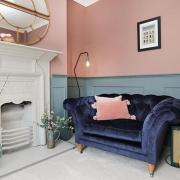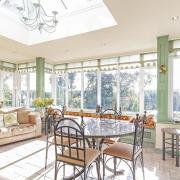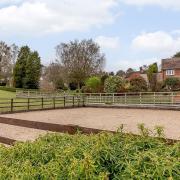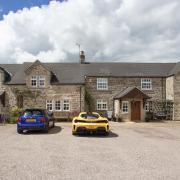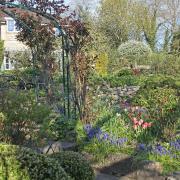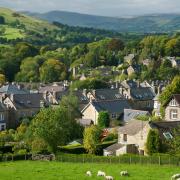As we approach the 200th anniversary of the birth of Florence Nightingale this May, Peter Kay – the owner and restorer of her family home in Holloway – talks to Pat Ashworth

I am very taken with the idea that as I drive across the parkland to Lea Hurst, I'm following the exact same route that Florence Nightingale would have taken in August 1856 when she returned home to the village of Holloway after her time in the Crimea.
Notoriously publicity-shy - she had no truck with celebrity - she arrived quietly by train to be met possibly at Ambergate, though a popular story is that she walked with her luggage from Whatstandwell. Her childhood home is entirely hidden from view until you pass through a series of gates and round a bend, and the sense of anticipation increases.
There's a plaque in the porch of what is now the family home of Peter Kay, his wife, Jen, and their five children. It dates from the half-century from 1951 when Lea Hurst was a care home, and remembers Florence's mother, whom Florence nursed here until her death at the age of 94. The text concludes, 'It is hoped that this house may be blessed with a spirit of fellowship and goodwill in keeping with the memory of Florence Nightingale.'
I can vouch for the fact that it is. I'm unavoidably delayed this morning and having sent an apologetic message to say that I'll be arriving up to an hour late, I'm met not with impatience but with freshly made sandwiches and a seat in the warm kitchen. Peter Kay, whose family hails from North Wales, bought Lea Hurst in 2011. Two years later, and whilst the family were still living in Asia, he embarked on a complete renovation of the 15-bedroom house, which had been in private hands since the care home closed in 2004.

He has gone beyond mere restoration, though. Studying paintings and photographs as a guide, his aim has been to return the house as far as possible to the way it looked when the Nightingales lived here, and to that end, with the help of art and antiques advisor Tim Corfield (www.corfieldmorris.com), he has managed to source items of Nightingale family furniture, art and memorabilia, replicate others and commission bespoke pieces and furnishings.
It has been a labour of love. We are sitting in what was the Library of what was originally a 17th century farmhouse, where Florence was home-schooled by her father, William. He inherited the house, part of the estate of his great-uncle, Peter Nightingale, in 1815 and the family moved in during 1825. With windows on three sides, one of them a deep bay leading out into the garden and parkland, it's a beautiful room and Peter has spent many contented hours in here. 'When William Nightingale inherited the house, he had no need to work and so devoted his life to his children,' he says.
'Florence was a very able and excellent student, with exposure to subjects and a depth of education that other women of her generation and social standing would not have had - science, maths, languages. She absorbed it all. I knew about the Crimean stuff but had no idea about her genius as a statistician, creating these unique charts to analyse and display data, which were part of the report she completed and presented to Queen Victoria in 1856.'
He is always on the lookout for tangible connections to the Nightingales and to the Crimea: letters, books and pictures, for instance. He is thrilled to have found a silk work Charge of the Light Brigade and a lithograph of the English fleet, both of which hang in this lovely room along with a portrait of Florence herself, a gift from Lea Primary School. There's a contemporary painting by an English Crimean officer, Captain H J Wilkinson, depicting British officers in Istanbul, with a dog. A repaired pocket Common Prayer and hymn book with a family inscription, is another small treasure, along with an edition of The Life and Death of Athena the Owlet, the story of Florence's pet owl written by her sister, Parthenope - both the Nightingale girls were named after the places they were born.

Two of the couple's children have been born here at Lea Hurst. Peter can breathe a sigh of relief at having reached the stage where the family can now step back and enjoy the house after the trials of the major work. Paint has been blasted off the stone of the mullioned windows; shutters have been repaired; Jacobean fireplaces discovered and restored so they look magnificently as though they have been untouched for centuries. 'It's done now, preserved for the generations to come. At the end of the day, we're only custodians, aren't we? We've done our bit,' he reflects.
The trigger was of course the approach to this year of 2020, the bicentenary of Florence's birth. At Lea Hurst, they're looking to actively promote and celebrate her life and work and are welcoming, among others, many visitors from the nursing fraternity in this, the International Year of the Nurse and Midwife. Visitors can now enjoy bed and breakfast here, notably in the Florence Nightingale Suite with its beautiful balcony overlooking the gardens. Elizabeth Gaskell stayed here in October 1854 and left a charming description of the place:
'High as Lea Hurst is, one seems on a pinnacle, with the clouds careering around one. Down below is a garden with stone terraces and flights of steps - the planes of these terraces being perfectly gorgeous with masses of hollyhocks, dahlias, nasturtiums, geraniums etc. Then a sloping meadow losing itself in a steep wooded descent (such tints over the wood!) to the River Derwent, the rocks on the other side of which form the first distance, and are of a red colour streaked with misty purple. Beyond this, interlacing hills, forming three ranges of distance; the first, deep brown with decaying heather; the next, in some purple shadow, and the last catching some pale, watery sunlight.'
That geography is unchanged: the family is getting on with replanting those named flowers in the garden of what became a country retreat and 'solace' for the Nightingales. Their main residence became Embley Park in Hampshire in 1826. Standing at the window of the stunningly restored Drawing Room, you can see Crich Stand on the distant horizon across a great sweep of land. There are sheep here, and deer, and bluebells in the spring.

We linger in front of a copy of Jerry Barrett's famous painting, The Mission of Mercy: Florence Nightingale receiving the Wounded at Scutari, which has pride of place in the hallway. Florence famously refused to sit for Barrett or for anyone else - 'Standing around doing nothing was not something she was keen on,' Peter says with affection. He has revelled in discovering more and more of Derbyshire history and of the Nightingales' connection to leading figures of the day, including American abolitionists like Sidney Howard Gay - a painting on glass at Lea Hurst came from the Gay house in Massachusetts.
'She was a lobbyist and activist, using her connections in Parliament with people like Sidney Herbert to pass legislation to benefit sanitation and healthcare. She lobbied intensively to reform the dreaded workhouse infirmaries, which was realised in 1867 with the adoption of the Metropolitan Poor Act. This can be seen as the first step towards universal access to health care, established with the launch of the NHS in 1948. Even before germs were discovered, she was on the case, very prescient in her thinking,' Peter says with admiration and respect.
The furnishings of the Drawing Room have been faithfully replicated by the Derbyshire upholsterer, Kevin Jackson of Jackson Interiors in Matlock, from a sketch of the Nightingale family sitting around the fire. Other photographs and old postcards have provided information on other parts of the house: a very ecclesiastical-looking window by the entrance came from the chapel of the 14th century Wakebridge Manor when the chapel was demolished in the 1840s - 'I guess they would have recycled things from these estates,' Peter reflects.
He would particularly like to recreate the scene on an old postcard showing Florence's carriage from the Crimea standing outside the front door. The carriage is currently on loan at Claydon House, 'but I'm on the case to have it here for a little while, for a photoshoot… She had it made in the Crimea and used it to get about,' he says. The essence of Florence is everywhere, especially upstairs in the Florence Nightingale Suite, the rooms she occupied in the years following her return from the Crimea and where, in response to Queen Victoria's request, she wrote her substantial report on the causes of death there. She travelled from Lea Hurst to present the report directly to Queen Victoria at Balmoral.

An American journalist from the prestigious Smithsonian magazine went into raptures on a recent visit, walking down to the canal and back along the River Derwent. 'You get a lovely mist creeping up the Derwent valley,' observes Peter as we stand at the window of Florence's sitting-room, looking across to the hills. Formerly in banking, he now works with an entrepreneurial company recycling carbon fibre, and is able to work mainly from home. 'I escape up here,' he says. 'It's an absolute privilege to be able to work like this.'
Lea Hurst, Lea Shaw, Holloway, DE4 5AT www.florencenightingalesuites.co.uk







